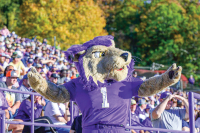Up Moses Creek: Beauty and the beast
 Named for the bright red wax droplets on its wings, the cedar waxwing can be found across much of North America. Fred Coyle photo
Named for the bright red wax droplets on its wings, the cedar waxwing can be found across much of North America. Fred Coyle photo
Birds were little more than nondescript flitting things to me that afternoon in January 1973, when I lay down on my bunk to sleep. It was on the second floor of a rundown WWII barracks at a Marine Corps airbase in southern California. I needed sleep because I worked nights in the base’s cavernous warehouse, Building 313, where my job was to find whatever parts the flightline mechanics needed to keep jet fighters and other military “birds” ready to bomb and strafe. But that afternoon not jet roars but soft, high-pitched, beckoning whistles came through the open door at the end of the barracks and woke me up. I walked out onto the stairway landing.
A large western juniper stood there. The tree was such a look-alike to the eastern red cedars I’d grown up with in North Carolina that, newly stationed in the West, I thought it was one. And there in its evergreen branches, almost in my face, were beautiful, feathered creatures eating the tree’s powdery-blue berries. Each bird stood out—pristine, clear-lined, vibrant, alert, with a swept-up crest, black facemask and yellow band across the tip of its tail. And each wing glowed with what looked to be drops of bright red wax. I’d fallen asleep Lance Corporal Kornegay, MOS 3072, aviation supply, at USMC Air Station El Toro — its insignia a musclebound flying red bull — and had been awakened as if by music at the dawn of creation, and I was glad to be alive.
After the birds flew off, I sketched their outline, added the waxy red dots, noted the “cedar berry” diet, then hurried to the base library, where I paged through nature guides until I came on a match: cedar waxwing. How could a bird be more aptly named than that!
The next day I bought binoculars and a Roger Tory Peterson field guide; and by year’s end, outdoors now every chance I could get, I had identified 150 birds in the book’s “Life List.” That very first sighting, cedar waxwing, was the one that opened my eyes.
So you can guess my delight recently when out of the blue a flock of waxwings descended on Moses Creek and landed whistling in the eastern red cedar beside our house. The tree was so berry-loaded it had a blue tinge, but after several days of feathered feasting, the waxwings left it evergreen again. Then they flocked to a holly.
I noticed that after gorging on the red holly berries, the waxwings flew to a black gum tree nearby where, stuffed, they slept side-by-side on its branches, as if to prop each other up. Later, they flew back to the holly for second then third helpings, each time returning to the same black gum branches looking so stupefied I thought they might fall off.
Related Items
When I told a friend in Chapel Hill about it, he said he’d seen waxwings do that — fall out of a holly to the ground, drunk on berry wine! Terres’s “Audubon Encyclopedia of North American Birds” confirms it: “Waxwings… may gorge until they can scarcely fly; sometimes get drunk on over-ripe fruit.”
The holly berries are big — in human terms, the size of an apple. But the birds bolt them down whole one after another.
One afternoon I came across two waxwings lying on the ground below my study window. The first was stunned by its collision with the glass; the other was dead. Becky hangs fluttery strips of cloth on our windows to warn off birds, but those two must have veered off course from the holly — FUI, flying under the influence.
I put the stunned one in an empty shoebox and set it in a quiet place. Later, hearing stirrings inside, I cracked the lid to the sky. The bird flew out so fast I felt the wind from its wings on my hands.
Picking up the dead waxwing, I found that the more I examined it the more beautiful the bird became. Its jet-black eye mask was offset by fine white lines. Its yellow, olive, cream and brown feathers blended into colors I have no names for. Each puff of down on the breast looked combed and unique. And all this exquisite perfection rose out of dark, cruelly clawed reptilian feet.
Those feet reminded me that according to paleontologists, birds have evolved from theropod (“beast-footed”) carnivorous dinosaurs. I imagined myself coming on an eight-ton Tyrannosaurus rex lying beside the house choked to death on a hog-sized hunk of meat. Its crude, three-toed feet and distended belly point skyward. Nubbins of quills sprouted from red splotches on its absurdly tiny arms.
Every beauty comes with its beast.
Burt Kornegay lives in Jackson County.









